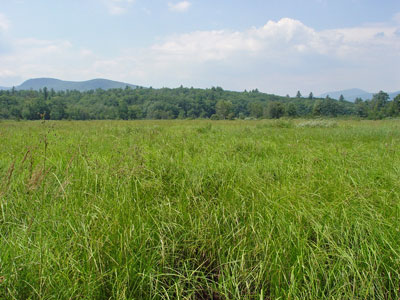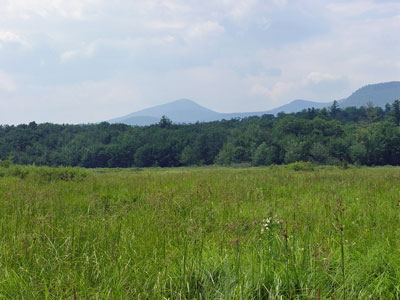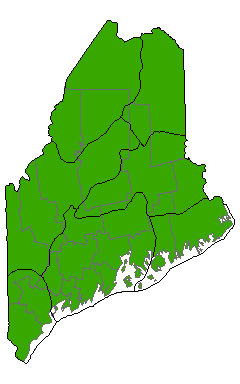DACF Home → Bureaus & Programs → Maine Natural Areas Program → Communities, Plants, and Animals → Natural Community Fact Sheets → Tall Sedge Fen
Printer Friendly Fact Sheet - 750 KB pdf (Get a free copy of Adobe Acrobat Reader)
Tall Sedge Fen
Scientific Name: Mixed Tall Sedge Fen State Rank: S4

- Community Description
- Soil and Site Characteristics
- Diagnostics
- Similar Types
- Conservation, Wildlife and Management Considerations
- Distribution
- Characteristic Plants
- Associated Rare Plants
- Associated Rare Animals
- Examples on Conservation Lands You Can Visit
Community Description: Expanses of tall sedges and grasses grow on saturated peat, with the silvery hue of slender sedge, typically the dominant species, often visible from a distance. Beaked sedge and lake bank sedge are also characteristic; the ubiquitous bluejoint is often present in small amounts. Tussock sedge may be present in small amounts but does not form dense tussocks. The herb layer is often continuous, and whatever shrubs occur are usually below or mixed in with the graminoid cover, except for an occasional alder or meadowsweet protruding above. Dwarf shrubs are usually <50% cover and always less abundant than the herbs. The bryoid layer varies from sparse to almost continuous, inverse to the amount of standing water. Back to top.

Soil and Site Characteristics: In wetland basins, this fen type occurs as part of a peatland or on peaty deposits adjacent to open water in a minerotrophic setting. The substrate is always saturated and is often flooded at high water. Sites are acidic to circumneutral (pH 4.8-6.8). Back to top.
Diagnostics: Tall peatland sedges, including slender sedge and beaked sedge, are dominant. Grasses such as bluejoint are present. Sites are often adjacent to open water. Sweetgale, leatherleaf, and meadowsweet, if present, are subdominant to the sedges. Back to top.
Similar Types: Sweetgale Fens share many species and can occur in similar settings but are strongly shrub dominated rather than herb dominated. Other graminoid dominated fen types feature different, less robust sedges, and usually have a more developed bryoid layer. Sedge Meadows can occur in similar settings but are strongly dominated by tussock sedge. Grassy Shrub Marshes can share some species, but occur on mineral substrates or on a thin organic layer over mineral soil, rather than on peat. Back to top.
Conservation, Wildlife and Management Considerations This community type is well represented in Maine and is fairly stable in extent, with several examples on public lands and private conservation lands. Impoundment or draining would have negative impacts on hydrology and on vegetation. Slow vegetation growth rates, due to the nutrient poor environment, result in slow recovery from physical disturbances. Degradation from recreational use is unlikely, because of the unstable substrate; but if disturbance, such as foot traffic, is a necessity, traversing during frozen conditions or using boardwalks can minimize impacts.
In southern Maine, these wetlands may provide habitat for several rare reptiles including ribbon snakes, Blanding’s turtles, and spotted turtles. The rare ringed boghaunter dragonfly, restricted to the southern part of the state in York and southern Oxford Counties, is found in this community, especially in very wet locations with peat moss often suspended in the water column. The black meadowhawk, an uncommon dragonfly of open fens and marshes, may also be found in this community. Sites in northern Maine may be inhabited by the subarctic bluet, an uncommon damselfly that inhabits open marshes and fens and reaches the southern edge of its range in northern Maine. Back to top.
Distribution: Statewide. Probably extends throughout northern New England, New York, and adjacent Canada, but not well documented. Landscape Pattern: Small to Large Patch. Back to top.


Characteristic Plants: These plants are frequently found in this community type. Those with an asterisk are often diagnostic of this community.
- Sapling/shrub
- Meadowsweet
- Dwarf Shrub
- Large cranberry*
- Leatherleaf
- Sweetgale
- Herb
- Beaked sedge*
- Bluejoint
- Lake sedge*
- Inflated sedge
- Silvery sedge
- Slender sedge*
- Three-way sedge
- Tussock sedge
- Yellow loosestrife
- Bryoid
- Sphagnum mosses*
- Blanding's turtle
- Ribbon snake
- Ringed boghaunter
- Spotted turtle
Examples on Conservation Lands You Can Visit
| Example | County |
|---|---|
| Fourth Machias Lake, Duck Lake Public Lands | Hancock Co. |
| Jones Pond, Bigelow Preserve | Franklin Co. |
| Killick Pond Wildlife Management Area | York Co. |
| Saco Heath Preserve | York Co. |